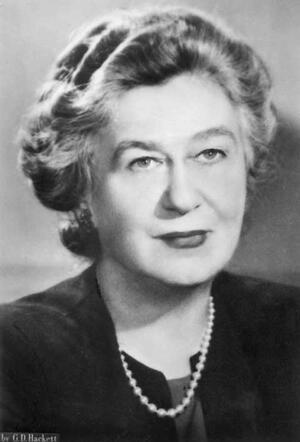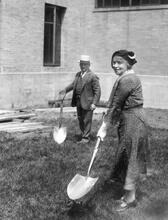Etta Lasker Rosensohn
Photographer: G.D. Hackett
Institution: Hadassah, The Women's Zionist Organization of America, Inc.
An influential philanthropist and social activist, Etta Lasker Rosensohn focused most of her energy on Zionist affairs. Rosensohn and her sisters attended the New York School of Social Work and became interested in working for the Jewish community. In 1918 they wrote a study called Care and Treatment of the Jewish Blind in the City of New York. At the National Council of Jewish Women, Rosensohn chaired the Department of Service to the Foreign-Born and founded the department’s newspaper. In 1939 she was elected as Hadassah’s representative to Hebrew University’s board. She also served on Hadassah’s board, chaired Hadassah’s Medical Organization Committee, and served as Hadassah’s president. Hebrew University honored her contributions to Hadassah’s medical work by establishing the Etta Lasker Rosensohn Chair of Bacteriology.
On September 25, 1966, David Ben-Gurion drafted a letter to a leading member of Hadassah, the Women’s Zionist Organization of America. “I just learned with sorrow the passing of my dear friend, Etta Rosensohn,” Ben-Gurion wrote. “I always admired her intellect and devotion for Hadassah and for the Jewish People. It is a great loss for Hadassah and for American Jewry.” Ben-Gurion’s handwritten letter of condolence offers testament to the prominence and success of Etta Lasker Rosensohn’s many years of work for Hadassah. Though Rosensohn geared much of her philanthropic career toward Jewish and Zionist affairs in New York City, her involvement with Hadassah proved to be the great passion of both her personal and professional life.
Early Life, Education, and Family
Henrietta (Etta) Lasker was born in August 1885, in Galveston, Texas, one year after the birth of her older sister, Florina, and one year before the birth of her younger sister, Loula. Both of her parents came from educated German Jewish backgrounds. Her father, the well-known businessman Morris Lasker, immigrated to the United States from East Prussia in 1856 at age sixteen. Her mother, Nettie Davis, was a third-generation Jewish American, who hailed from a town near Rochester, New York. Except for a brief stint living in Germany in 1893, Etta, her sisters, and three brothers came of age in a wealthy Galveston community. After attending college at the University of Texas, she moved to New York City and, like so many other elite women of her day, devoted her life to social and philanthropic work.
Etta and her sisters attended the New York School of Social Work and became trained social workers interested in working for the Jewish community. In 1918, they authored a study for the Bureau of Philanthropic Research called Care and Treatment of the Jewish Blind in the City of New York. That same year, Etta met and married Major Samuel J. Rosensohn, a lawyer and an assistant in labor relations to Secretary of War Newton Baker during World War I. They raised two children, William and Janet. Samuel Rosensohn died in 1939.
After World War I, Rosensohn and her sisters became affiliated with the National Council Of Jewish Women, where Rosensohn served until 1930 as chairperson of the Department of Service to the Foreign-Born and founded that department’s newspaper, The Immigrant.
Hadassah
Although Rosensohn also pursued a wide diversity of philanthropic activities in the interwar years, her central commitment to Hadassah was confirmed as early as August 1939 by her election as Hadassah’s representative to the board of governors of the Hebrew University of Jerusalem. Henrietta Szold, founder of Hadassah, was the only other female member elected at this time to the university’s governing body. A member of the national board of Hadassah for more than two decades, Rosensohn also served as national president from 1952 to 1953. Immediately before her tenure as president, she served as chair of the Hadassah Medical Organization Committee. Of all of her interests, Rosensohn ultimately considered Hadassah’s medical work to be her top professional priority. From 1939, for instance, Rosensohn played an integral role in the founding and expansion of the Hebrew University–Hadassah Medical School in Jerusalem. In 1959, Hebrew University honored her for her longtime commitment to Hadassah’s medical work by establishing the Etta Lasker Rosensohn Chair of Bacteriology at the Hebrew University Medical School.
When Etta Lasker Rosensohn died on September 20, 1966, in New York City, many social and political activists agreed with David Ben-Gurion’s sentiment that her death represented a great loss for Hadassah and for American Jews.
AJYB 68:532.
EJ; Gunther, John. Taken at the Flood: The Story of Albert Lasker (1960).
Obituary. NYTimes, September 21, 1966, 47:2.
Obituary of Florina Lasker. NYTimes, September 2, 1949, 17.
Rosensohn, Etta Lasker, Care and Treatment of the Jewish Blind in the City of New York, with Florina Lasker and Loula Lasker (1918), and Papers. Hadassah Archives, NYC.
UJE 7.
WWIAJ (1926, 1928, 1938).
WWWIA 4.




